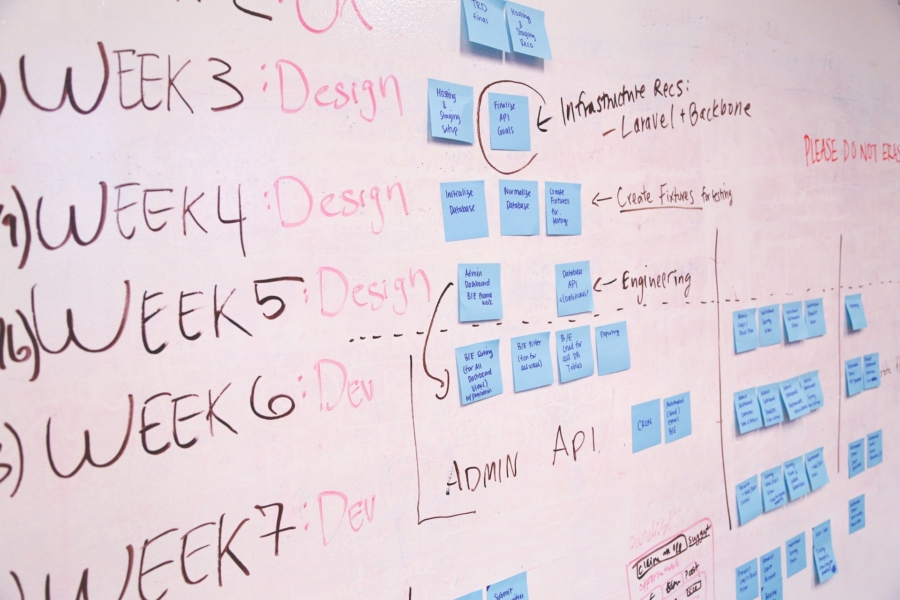Michael Dlugosch works as a Senior Consultant at Kwantic Oy, a Web Analytics startup company in Helsinki/Finland. While not working, Michael can be found taking photographs or preparing home-made pasta. Equipped with a true passion for the Internet since his first encounter with it in 1996, Michael has been jumping around in Digital Agencies since 2000, running digital projects, web productions and teams, consulting as a Usability Specialist and, lately, as a Web Analytics Consultant.
We’ve all been tempted, we’ve all been there…
Tiresome digital projects without end, endless discussions with the client, never-ending resourcing problems, budget cuts, technical systems not working and changing scopes all over the place – everything turning upside down faster than you can spell change request!
No doubt about it, digital project management is not an easy job.
However, during my own involvement with digital projects I’ve had to witness particular things which were said by team members, in front of the client, and within the team itself, and these things did nothing else but add to the confusion and difficulties that all digital projects already have too much of even at the best of times, making the job of the Digital Project Manager that much more challenging.
I tend to call these things the “Seven Deadly Sins of Digital Project Management” and within this series of four articles I will describe and illustrate them, with examples – along with my best practice advice on how to deal with the temptations we all face.
1. Vanity – “We know better than the client!”
Let’s assume you work for an agency which has a certain experience in the field and has been running digital projects for several years now, think how many projects have you and your team been involved in? 20? 50? Maybe even 100…
An average client has run only a few and often has only one primary goal; he or she needs to satisfy the expectations that have been set by their superiors.
While it has become commonplace in web agencies to internally share the most outrageous briefings and the insane functionality requests for a good laugh with the project team, it should always be coupled with attempting to help your client by communicating with them better.
Of course you know more about digital projects and digital project management – so why don’t you start educating your clients accordingly? Take the following example of client feedback we’ve all heard and laughed at:
“Thank you for the screenshot of the HTML newsletter you sent. The layout looks ok, and the copy looks good. But not a single link works in the .jpg file you’ve sent me. You are going to fix that before sending the campaign, right?”
There is a wrong and a right response to this request. If you’re pressed for time, simply reply:
“Yep, we’ll take care of everything before we send it out.”
Don’t reply with:
“This is a screen shot, you stupid butthole! Of course the links don’t work in it!”
If you’re a patient person with nerves of steel, you could say:
“Hey, thanks for your feedback. We’ll take this as approval for the newsletter layout and content, and will make sure that all the links in the final version are functional and being tracked. Our technicians cannot yet exactly predict how long it takes to complete the newsletter batch delivery for all 3428 addresses, but we have scheduled to send the first campaign blast with 500 addresses at 2am tonight.
The file you’ve reviewed represents just an image version (jpg) of the final newsletter file (HTML) and thus doesn’t include any active link functionality. This is to ensure we do not inflate the click-through numbers during testing…”
See the difference? Embedding your sharp reply inside a plethora of “this will happen next in the process” information is serving two purposes:
- It gives the client more information that they can hand over to their respective superiors
- It educates the client about some tiny details in web technology
A colleague of mine once labelled this approach as “killing with kindness”.
Admittedly it takes time to write such lengthy replies. But by tying your reply to the next steps in the agreed process you do yourself and your client several favours:
- You’re re-assuring your own understanding of the tasks that need completing
- You give them the correct language to frame the project status and next steps to their superiors
This makes it easier to deal with upcoming requests from the client’s organisation as you easily can prove how deeply intertwined the single tasks are.
Also, at all times you are depending on your client’s political position within their own organisation and are literally casting silver bullets for them that they can fire from their corporate rifle. They may use the additional and contextual information that you give them to brag, fight back unreasonable requests or to claim as their own, but in all cases you can assist in making your client appear in a brighter light by filling them with digital project specific information and terminology.
Remember, as a Digital Project Manager one of your many roles is to make the client look fantastic to their superiors, do this and you’ll only improve your chances of repeat business.
But wait, isn’t that the job of the Account Manager?
2. Envy – “account management… I could do a better job myself!”
Many times I’ve witnessed Account Managers leave the office, much to the envy of the digital project team and Digital Project Manager as they are still clocking the hours up long into the night. As the leader of a digital project team you are of course, more often than not, sharing cold pizza with your project team rather than seeing your friends and family in the evening.
But remember this distinct advantage of being a Digital Project Manager over an Account Manager… by definition – A digital project is a temporary endeavour with a fixed start and end date and so sooner or later it will be over – account management is never over.
Nothing prevents any client from calling up your fellow Account Manager at 10pm to discuss an article about how the latest web trends in viral marketing will influence the company’s performance on social media perception within the next twelve months from now on.
What looks so easy during daytime often proves to require an “always on” mentality for Account Managers, and trust me, wining and dining with clients is not as much fun as it sounds (although the food and drinks are on the house, mostly).
The only currency that an Account Manager has is trust. However, gaining, and keeping, the client’s trust is essential for both Digital Project Managers and Account Managers.
But while Digital Project Managers have very clear boundaries – delivering digital projects – Account Manager’s success criteria are a little more blurry. While Digital Project Managers may get adulation and praise for their constant supportive role (aka pulling rabbits out of hats – aka saving the client’s butt), Account Managers often find it more difficult to get famous for their deeds.
Maybe that is the reason why Account Managers are so often interfering and messing around with digital projects, and the people involved in them, when it is not necessary – because it seems so much easier and more instantly rewarding when compared with what they normally do.
It occasionally seems to me that it’s the Account Manager’s secret job to promise what others have to deliver with no real clear idea if it is even possible, but the reality is a usually more brittle than that – thus putting the Account Manager in a difficult position.
While Digital Project Managers have to deliver within a defined scope, Account Managers have to account for future scopes. At any time, a current client can approach a direct competitor of yours to begin talks about receiving the same service with improved quality and lower costs.
The Account Manager’s job is precisely this – to decrease the likelihood of this happening.
Operational, tactical and strategic are the names of the fictional stages of the continuum that both types of Web Managers have to tackle on a daily basis. While the operational side deals more with things that have already been agreed (projects and deliverables), the strategic level deals more with the ‘yet unknown things to come’, involving, for example, planned co-operations with institutions nobody has yet heard of and the instant need for ramping up your agency’s workforce by 385% within the next eight months.
The really tricky thing is that the Account Manager is held responsible for is the substantial monetary growth of the account through targets based on many unknowns.
So as a Digital Project Manager, while continuing to attempt to keep the Account Manager away from the day to day running of your project, understand why Account Managers may insist on doing this before berating them.
In Part 2 Michael discusses his next two Deadly Sins of Digital Project Management. How to keep digital projects on budget without having to ask the client for an additional 2 million, and how the Digital Project Manager should be willing to serve the project first and themselves second – Gluttony and Lust.









This is a very wise article (whom I happen to know also). It reminds us to look at the needs of others through the eyes of others, to respect their needs with our patience, time and courtesy. I have moved around in production, project management, account management and client roles myself, and this is very true from all perspectives. To me, the one thing to remember is to stop and think before you respond to people. It’s not always possible, of course. But equally it’s true that seeing things from the other guy’s perspective is habit-forming if you give it a try. Sound advice, Michael. Looking forward to the next chapter.
Thanks for this well-written article! Your description of sales VS project management is right on the money. While the sales job may look glamorous from the outside, there is a lot of hidden work (which comes with the company phone and the expense account). It would be interesting to see how we can explain the job of project management to the sales team.
I love this article. Great post. The relationship between client services and project management is so crucial to the project’s success. At the end of the day what matters most is delivering to the client what was agreed on time and on budget while exceeding their expectations. Stay focused on that and everything else will work itself out.
As a Web Project Manager I don’t think you can ever read enough articles, like this one from Michael, that remind you always to make it your mission to educate your client, make them look good to their superiors and consider why people may be meddling in your projects… I think all of us at one time or another lose sight of these important cornerstones of good project management!
Look out for the next part in a few days, it’s just as good :)
Keeping projects headed in the right direction seems to really come down to education for me typically. Whether it’s educating clients on how things work and processes or educating team members on why a trivial request from the client is soo important to them, it’s about education and keeping your cool.
I recently wrote something in much of the same vain you may find amusing, http://www.departika.com/blog/comments/how_to_blank_without_being_a_jerk_1/
Great article and looking forward to the next part.
@Stuart: in such a fast-paced industry it occasionally feels like luxury to think for a minute, indeed. But I’ve always found it worthwhile, too.
@Karine: that might make another nice post. Being busy with integrating sales processes and PM processes at the moment I will surely give this topic a lot of thoughts in the upcoming weeks anyway…
@Allyson: Fully agree! I am constantly surprised how little “expectation management” is considered an important domain in Project Management…
@thesambarnes: Yep. It is the ability to see all the facets of “What”, “How” and “Why” which makes a good PM, isn’t it?
@Corey: Education and elaboration, yes. Did you yet write that other thing, “How to talk to employees without being a jerk”?
@ all: thank you very much for your kind words. Hope you’ll enjoy the next couple of posts as well.
Hey, a very valuable piece of information, eh?
For your second sin, the Account Manager and the Project Manager are often combined into one in small to medium sized companies (eg. the PM is the same as the Account Manager). Although stressful, this combined role will definitely add a lot of value to the web Project Manager AND s/he doesn’t have to envy anyone anymore. I personally think that dealing with the client is fun for the others, but not for the person actually dealing with the client. Clients can be quite stressful, not to mention that whoever dealing with the client has also to deal with internal resources, which is another story…
PS: I’ve published an elaborate article on how to write proposals for web projects, which I think your readers might find useful.
@PM Hut, I totally agree with your comments about the Account Management and Web Project Management roles often being combined, in fact, I’ve just finished writing a three part series on that very subject that I’ll publish after the Deadly Sins one is done :)
Thanks for the link about writing proposals for web projects, I thought it was REALLY good!
There really just is’nt enough posts specifically about web projects so it’s great to see posts like yours…
Some great observations all sounding dreadfully familiar!
@Web Design, but that is somewhat of a comfort I find, hearing others in the same boat!
Nice Article. I would like to further add that some management failure is also a biggest cause of project management failure.Hence, the first priority of a project manager is to highlight in the start what have to do and what not have to do. He should keep himself as well as his team from gold plating.